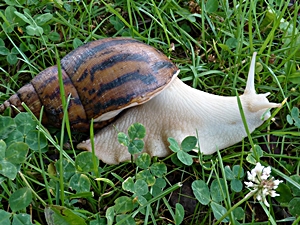
Giant African land snail (Achatina achatina). The animal shown
is a body albino. Picture: Martina Eleveld.
 Giant African land snail (Achatina achatina). The animal shown is a body albino. Picture: Martina Eleveld. |
In the family Achatinidae of great African land snails there are among the largest terrestrial snails on Earth. Compared to a great African land snail, that may well reach twenty to thirty centimetres (eight to twelve inches respectively), the Roman snail (Helix pomatia), the largest terrestrial snail in Europe, with its ten centimetres length (four inches) at most, appears tiny.
The large species of great African land snails, as their name says, occur mostly in tropical Africa. So the natural area of distribution of Achatina achatina and Archachatina marginata is in West Africa (achatina from Liberia to Nigeria, marginata from Cameroon to Zaire) and that of Achatina (Lissachatina) fulica in East Africa. The shell of an agate is longer than wide, formed similar to a European bulin (Ena) – conical with an extended body whorl and a blunt apex.
Today giant African land snails are found far outside their original area of distribution, everywhere on Earth where the natural environment, such as climate and food, make life possible for so large snails.
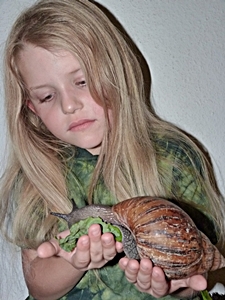 Giant African land snail (Achatina achatina, 17 cm (7 in.), 380 g). Picture: Martina Eleveld. |
Agate snails have been distributed mainly by man: Eggs were transported with food transports from Africa to many countries on earth. In Africa agates are also kept as a food source, like "escargots" in Europe. Similar experiments have been made elsewhere in the world. Giant African land snails have also been exported as pets.
Snails might not appear to be the common kind of pet, but giant African land snails seem to be an exception. Especially in Britain, but also in continental Europe, agates enjoy a growing popularity. They are kept similar to a tortoise: Agate discussion boards and terraristics fairs are full of giant African land snail enthusiasts, who even can tell apart the many races of their favourite species.
In schools there are also many projects to keep and observe the large terrestrial snails. Because of their uncommon size, the snails are especially interesting to students of all ages.
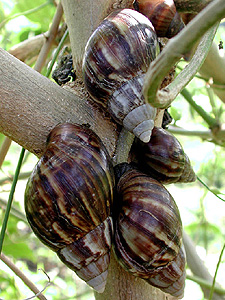 Giant African land snails (Achatina fulica). Picture: David Robinson. APHIS, NAS. |
In contrary to that in the United States it is illegal to keep giant African land snails. There are fines of even prison sentences. The reason is that the introduced snails mean an exceptional threat to agricultural areas in the subtropical states of the USA, such as Hawaii. Agates occurring in large numbers can destroy a whole plantation field in one night. Roads may become impassable due to snail slime.
The giant African land snails are mainly herbivores feeding on fruit and vegetables, the most nutritious parts of a plant. That way, in the United States they are harmful to more than 500 species of crop plants. Kept in captivity, agate snails regularly receive minced meat to provide them with proteins. Neither will those snails keep from feeding on a dead animal to provide themselves with protein, even if they are usually herbivorous.
Systematically agate snails are terrestrial pulmonates of the Stylommatophora order, which means they are hermaphrodites usually laying eggs. In some species there is also ovovivipary: The juveniles hatch inside the mother's body and are born alive.
In tropical and subtropical climate, giant African land snails are used to breed four times a year. The egg batch of some species may contain as many as 500 eggs of a size similar to many smaller snail species' adults. So in favourable climatic and food conditions, agate snails are able to proliferate.
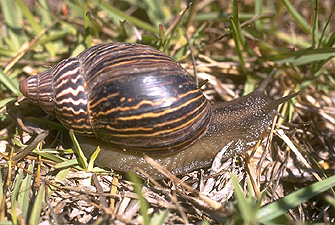 Giant African land snail (Achatina varicosa). Picture: Dr. H. Vannoy Davis © California Academy of Sciences. |
A fertilised agate snail can found a new population, if young snails hatch from all of its 500 eggs and become mature. However, agate snails are not able to fertilise themselves, as there is protandry. That means, in an agate snail's hermaphroditic gland (the gonad) in the genital apparatus, sperm cells develop first and are then deployed during mating, afterwards stored in a special sperm pouch in the other snail's genital apparatus. Only later, when eggs are supposed to be laid, egg cells develop in the same hermaphroditic gland and are afterwards fertilised with sperm cells from the sperm pouch. The fertilised egg cells then develop into eggs, which can be laid.
There is almost no cure against giant African land snails. During the day the snails remain hidden in the vegetation, also their egg batches are hard to find, as they are buried in the ground. So it is difficult to find ecologically feasible means against agate snails, such as catching them in traps or picking them up.
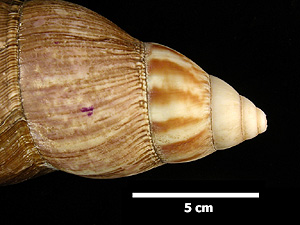 Shell tip (apex) of Achatina fulica for identification. Picture: Ken Walker, Museum Victoria (Australia). |
There have been experiments to regulate agate snails, with predator snails from Florida (the rosy wolf snail Euglandina rosea) and the Mediterranean (Rumina decollata), but neither of both was keen to attack the large agate snails, but rather preyed on smaller endemic snail species. Especially in vulnerable island ecosystems, such as the Pacific islands of French Polynesia, this has resulted in severe harm to endemic snail populations, many of which have since gone extinct.
In the Caribbean, as well as in their original area of distribution, agate snails are kept and collected as food. Like many other natural products, the snails are said to have an invigorating effect, so they are also sold as an aphrodisiac. So, on the islands of Sao Tomé and Principe exactly the opposite of the ecological problems mentioned before happened: Because of the native population collecting agate snails for food, the indigenous species of Achatina bicarinata has almost been extinct on those islands. Archachatina marginata, introduced from the mainland, had further harmful effect on the indigenous snail fauna by introducing parasites and competing for food.
Further information:
Literature:
Books:
Newspaper Articles: